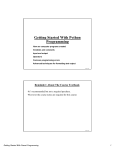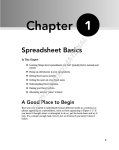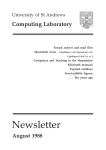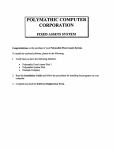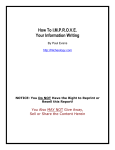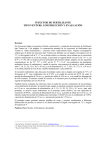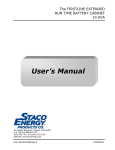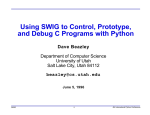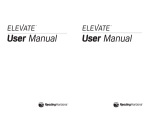Download Acrobat
Transcript
Getting Started With Python
Programming
•How are computer programs created
•Representing information with binary
•Variables and constants
•Input and output
•Operators
•Common programming errors
•Advanced techniques for formatting text output
James Tam
Reminder: About The Course Textbooks
•They’re a recommended but not required.
•However the course notes are required for this course
James Tam
Programming: Introduction
Reminder: How To Use The Course Resources
•They are provided to support and supplement this class.
•Neither the course notes nor the text book are meant as a
substitute for regular attendance to lecture and the tutorials.
James Tam
Reminder: How To Use The Course Resources (2)
procedure add (var head
: NodePointer;
var newNode : NodePointer);
var
temp : NodePointer;
begin
if (head = NIL) then
head := newNode
else
begin
temp := head;
while (temp^.next <> NIL) do
temp := temp^.next;
temp^.next := newNode;
end;
newNode^.next := NIL;
end;
James Tam
Programming: Introduction
Reminder: How To Use The Course Resources (2)
procedure add (varkhead
: NodePointer;
...w
e
a newNode
n
cla hen
var
: NodePointer);
o
m
p
s
su ss m yo
var
las ch u t
u
p
c
t
y
e
)
a
a (g es
ou plem ake do
temps: NodePointer;
c
t
s
r
a
u
d
int ow en sur mak
mi t yo sse s no
begin
t
e
e
t
u
i
h
e e gon n no the tha it t
yo tha u =mNIL)
lasthen
t
n
s
c
t
If rife (head
x
e
l
y o
o s
am a r
i
em s (c des ou
t y n:=e’newNode
su ahead
s
a
h eo
if y em us wi
welse
m
ou be e y th
o
s
do r it ou
begin
n’t in
temp := head;
)
while (temp^.next <> NIL) do
temp := temp^.next;
temp^.next := newNode;
end;
newNode^.next := NIL;
end;
James Tam
How To Succeed
•Successful people
Leonardo da Vinci
J.R.R. Tolkien
Bruce Lee
Amadeus Mozart
Wayne Gretzky
James Tam
Programming: Introduction
How To Succeed In This Course
1. Practice things yourself.
- You get better by doing things for yourself (this is a ‘hands-on’ field of
study and work).
- Write lots programs.
• At the very least attempt every assignment.
• Try to do some additional practice work (some examples will be given in
class, some practice assignments will be available on the course web page).
• Write lots of little ‘test’ programs to help you understand and apply the
concepts being taught.
- Trace lots of code
• Reading through programs that other people have written and
understanding how and why it works the way that it does.
James Tam
How To Succeed In This Course (2)
2. Make sure that you keep up with the material
-
Many of the concepts taught later depend upon your knowledge of
earlier concepts.
Don’t let yourself fall behind!
At least attempt all assignments!
:
Problem decomposition
Loops/repetition
Decisions/branching
Introduction to programming
Introduction to computers
James Tam
Programming: Introduction
How To Succeed In This Course (3)
3. Look at the material before coming to lecture so you have a
rough idea of what I will be talking about that day:
a) Read the slides
b) Look through the textbooks (if you got it)
James Tam
How To Succeed In This Course (4)
4. Start working on things as early as possible:
-
Don't cram the material just before the exam, instead you should be
studying the concepts as you learn them throughout the term.
Don’t start assignments the night (or day!) that they are due, they may
take more time than you might first think so start as soon as possible.
James Tam
Programming: Introduction
How To Succeed In This Course: A Summary
1. Practice things yourself
2. Make sure that you keep up with the material
3. Look at the material before coming to lecture
4. Start working on things early
James Tam
Computer Programs
Binary is the language of the computer
Translator
e.g., python
1) A programmer
writes a computer
program
2) A translator
converts the
program into a
form that the
computer can
understand
3) An
executable
program is
created
4) Anybody who has
this executable
installed on their
computer can run
(use) it.
James Tam
Programming: Introduction
What Is Binary?
•(What you know): Binary is a method of representing
information that uses two states.
•(What you may not be aware of): The number system that you
are familiar (decimal) uses 10 states to represent information.
James Tam
How Is Decimal Used To Store Numeric
Information
•Base 10
- 10 unique symbols are used to
represent values
The number of digits is
based on…the number of
digits
0
1
2
3
4
5
6
7
8
9
10
:
The largest decimal value that can be
represented by a single decimal digit is 9
= base(10) - 1
James Tam
Programming: Introduction
How Does Counting In Decimal Work?
0
1
2
3
4
5
6
7
8
9
10
11
12
13
14
15
16
17
Column 1
counts
through all
10 possible
values
For the next value,
column 1 resets back
to zero and column 2
increases by one
Column 1 counts
through all 10
possible values,
column 2 remains
unchanged
18
19
20
21
22
23
24
25
26
27
28
29
30
31
Etc.
Column 1 counts
through all 10
possible values,
column 2 remains
unchanged
For the next value,
column 1 resets back
to zero and column 2
increases by one
James Tam
Decimal: Summary
•Base ten
•Employs ten unique symbols (0, 1, 2, 3, 4, 5, 6, 7, 8, 9)
•Each digit can only take on the value from 0 – 9
- Once a column has traversed all ten values then that column resets back to
zero (as does it’s right hand neighbours) and the column to it’s immediate
left increases by one.
James Tam
Programming: Introduction
Binary: Summary
•Base two
•Employs two unique symbols (0 and 1)
•Each digit can only take on the value 0 or the value 1
- Once a column has traversed both values then that column resets back to zero
(as does it’s right hand neighbours) and the column to it’s immediate left
increases by one.
James Tam
Counting In Binary
Decimal value
Binary value
Decimal value
Binary value
0
0000
8
1000
1
0001
9
1001
2
0010
10
1010
3
0011
11
1011
4
0100
12
1100
5
0101
13
1101
6
0110
14
1110
7
0111
15
1111
James Tam
Programming: Introduction
How Is Binary Used?
•Representing instructions in a computer program
- E.g., print “End program.” onscreen translates to
- 0001 1000 1010 1111
- 0100 0101
- 0110 1110
- Etc.
•Representing the data in a computer program
- Alphanumeric text is represented with a numeric code (decimal ASCII
value) which is translated to a binary ASCII value (e.g., ‘A’ = 65 = 0100
000). (In UNIX type “man ascii” for all the ASCII codes).
- Signed integers can be represented by using one bit representing the sign
of the number and the remainder of the bits representing the size of the
number.
Sign bit:
0 = positive
1 = negative
Remaining bits (n-1):
Used to represent the
size of the number.
James Tam
How Is Binary Used? (2)
- Signed real numbers are more complex and require three parts
Sign bit
Mantissa bits
b
bbbb
Exponent bits
bbb
- The mantissa is raised to the exponent in order to determine the size of the
number.
- Example:
0010
0
Positive
Two
011
Three
Number: Positive 2 cubed...the
number positive 8 is being
represented in signed binary.
James Tam
Programming: Introduction
Why Is It Important To Know How Data Is Being
Stored?
•Different representations store different types of information but
some have drawbacks.
•Real number representations may result in a loss of accuracy:
- Only an approximation of some fractional values may be stored e.g., 1/3
- Even storing some non-repeating fractional values may result in the loss of
some information.
- Example: suppose 1 digit is used for the sign, 5 for the mantissa and 3 for
the exponent.
• 123.45 is represented as 12345 * 10-2
• 0.12 is represented as 12000 * 10-5
• 123456 is represented as 12345 * 101
•Morale of the story: Don’t store information as a real number if
it can be stored as an integer because of the potential loss of
accuracy (e.g., store monetary values as cents rather than
dollars).
James Tam
Storing Other Information
•Text: ASCII represents simple alphanumeric information
8 bits:
1 used for error checking
7 for the alphanumeric information = 128 combinations
•Text: beyond simple English representations
- Arabic, Dutch, Chinese, French, German etc.
- Representing this expanded text information uses additional bits:
• 16 bits = 65,536 combinations
• 24 bits = 16,777,216 combinations
James Tam
Programming: Introduction
Storing Other Information (2)
•Colors: using ~16 million colors can present a ‘true life’
representation, how are the color combinations encoded?
James Tam
Converting From Binary To Decimal
•Start with some binary number to convert:
- E.g., 1 0 1. 1
•Label each of the binary digits:
- Starting with the digit immediately left of the decimal point and moving
left (away from the decimal point) label the binary digits 0, 1, 2, 3 etc. in
succession.
- Starting with the digit immediately right of the decimal point and moving
right (away from the decimal) label the binary digits -1, -2, -3...
2 1 0 -1
- E.g., 1 0 1. 1
Position of each binary digit
Binary number to be converted
•Evaluate the expression: the binary digit raised to some
exponent1, multiply the resulting expression by the
corresponding digit and sum the resulting products.
Value in decimal = (1x22) + (0x21) + (1x20) + (1x2-1) = (1x4) + (0x2) + (1x1) +
(1 * 1/2) = 4 + 0 + 1 + 0.5 = 5.5
1 The value of this exponent will be determined by the position of the digit (value of the superscript)
Programming: Introduction
James Tam
Binary To Decimal: Other Examples
•0101.112 = ????10
•1000002 = ????10
•0111112 = ????10
James Tam
Decimal To Binary
Split up the integer and the fractional portions:
1) For the integer portion:
a. Divide the integer portion of the decimal number by two.
b. The remainder becomes the first integer digit of the number (immediately
left of the decimal) in binary.
c. The quotient becomes the new integer value.
d. Divide the new integer value by two.
e. The new remainder becomes the second integer digit of the binary
number (second digit to the left of the decimal).
f. Continue dividing until the quotient is less than two and this quotient
becomes the last integer digit of the binary number.
James Tam
Programming: Introduction
Decimal To Any Base (2)
2) For the fractional portion:
a. Multiply by two.
b. The integer portion (if any) of the product becomes the first rational digit
of the converted number (first digit to the right of the decimal).
c. The non-rational portion of the product is then multiplied by two.
d. The integer portion (if any) of the new product becomes the second
rational digit of the converted number (second digit to the right of the
decimal).
e. Keep multiplying by two until either the resulting fractional part of the
product equals zero or you have the desired number of places of
precision.
James Tam
Decimal To Any Base (2)
•e.g., 910 to ???2
1 001
2
9 / 2: q = 4 r = 1
4 / 2: q =2 r = 0
2 /2: q = 1 r = 0
1
Stop dividing! (quotient less than target base)
James Tam
Programming: Introduction
Decimal To Binary: Other Examples
•5.7510 = ????2
•3210 = ????2
•3110 = ????2
James Tam
Python
• This is the name of the programming language that will be
used to illustrate different programming concepts this semester:
- My examples will be written in Python
- Your assignments will be written in Python
• Some advantages:
- Free
- Powerful
- Widely used (Google, NASA, Yahoo, Activision, Electronic Arts etc.)
• Named after a British comedy
Monty Python © BBC
• Online documentation: http://www.python.org/doc/2.5.2/
James Tam
Programming: Introduction
An Example Python Program
•You can find an online version of this program in UNIX under
/home/231/examples/intro/small.py:
Filename: small.py
print “hello”
James Tam
Creating, Translating And Executing Python
Programs
Text editor
To begin creating a Python program in
UNIX type "XEmacs filename.py"
XEmacs
Python program
filename.py
(Text file)
Python
translator
python
To translate and execute the
program in UNIX type “python
filename.py"
Effect of execution:
• Message appears
onscreen
• File is opened
• Etc.
James Tam
Programming: Introduction
Displaying String Output
•String output: A message appears onscreen that consists of a
series of text characters.
•Format:
print “the message that you wish to appear”
•Example:
print “foo”
print “bar”
James Tam
Variables
•Set aside a location in memory
•Used to store information (temporary)
- This location can store one ‘piece’ of information
- At most the information will be accessible as long as the program runs
•Some of the types of information which can be stored in
variables:
- Integer
- Real numbers
- Strings
Picture from Computers in your future by Pfaffenberger B
Programming: Introduction
James Tam
Variable Naming Conventions
-Should be meaningful.
-Names must start with a letter (Python requirement) and
should not begin with an underscore (style requirement).
-Can't be a reserved keyword (see next slide).
-Names are case sensitive but avoid distinguishing variable
names only by case (bad style).
-Variable names should generally be all lower case.
-For variable names composed of multiple words separate each
word by capitalizing the first letter of each word (save for the
first word) or by using an underscore. (Be consistent!)
James Tam
Key Words In Python1
and
del
from
not
while
as
assert
elif
global
or
with
else
if
pass
yiel
break
except
import
print
class
exec
in
raise
continue
finally
is
return
def
for
lambda
try
1 From “Starting out with Python” by Tony Gaddis
James Tam
Programming: Introduction
Constants
•Memory locations that shouldn’t change.
•The naming conventions for choosing variable names generally
apply to constants but the name of constants should be all
UPPER CASE. (You can separate multiple words with an
underscore).
•They are capitalized so the reader of the program can
distinguish them from variables.
- For some programming languages the translator will enforce the
immutability of the constant.
- For languages such as Python it is up to the programmer to recognize a
constant for what it is and not to change it.
James Tam
Why Use Constants
1. They make your program easier to read and understand
populationChange = (0.1758 – 0.1257) * currentPopulation;
Vs.
BIRTH_RATE = 17.58
Magic Numbers
(avoid whenever
possible!)
MORTALITY_RATE = 0.1257
currentPopulation = 1000000
populationChange = (BIRTH_RATE - MORTALITY_RATE) *
currentPopulation
James Tam
Programming: Introduction
Purpose Of Named Constants (2)
•2) Makes the program easier to maintain
• If the constant is referred to several times throughout the program,
changing the value of the constant once will change it throughout the
program.
James Tam
Purpose Of Named Constants (3)
BIRTH_RATE = 0.1758
MORTALITY_RATE = 0.1257
populationChange = 0
currentPopulation = 1000000
populationChange = (BIRTH_RATE - MORTALITY_RATE) * currentPopulation
if (populationChange > 0):
print "Increase"
print "Birth rate:", BIRTH_RATE, " Mortality rate:", MORTALITY_RATE, " Population
change:", populationChange
elif (populationChange < 0):
print "Decrease"
print "Birth rate:", BIRTH_RATE, " Mortality rate:", MORTALITY_RATE, "Population
change:", populationChange
else:
print "No change"
print "Birth rate:", BIRTH_RATE, " Mortality rate:", MORTALITY_RATE, "Population
change:", populationChange
James Tam
Programming: Introduction
Purpose Of Named Constants (3)
BIRTH_RATE = 0.8
MORTALITY_RATE = 0.1257
populationChange = 0
currentPopulation = 1000000
One change in the
initialization of the
constant changes every
reference to that
constant
populationChange = (BIRTH_RATE - MORTALITY_RATE) * currentPopulation
if (populationChange > 0):
print "Increase"
print "Birth rate:", BIRTH_RATE, " Mortality rate:", MORTALITY_RATE, " Population
change:", populationChange
elif (populationChange < 0):
print "Decrease"
print "Birth rate:", BIRTH_RATE, " Mortality rate:", MORTALITY_RATE, "Population
change:", populationChange
else:
print "No change"
print "Birth rate:", BIRTH_RATE, " Mortality rate:", MORTALITY_RATE, "Population
change:", populationChange
James Tam
Purpose Of Named Constants (4)
BIRTH_RATE = 0.1758
MORTALITY_RATE = 0.01
populationChange = 0
currentPopulation = 1000000
One change in the
initialization of the
constant changes every
reference to that
constant
populationChange = (BIRTH_RATE - MORTALITY_RATE) * currentPopulation
if (populationChange > 0):
print "Increase"
print "Birth rate:", BIRTH_RATE, " Mortality rate:", MORTALITY_RATE, " Population
change:", populationChange
elif (populationChange < 0):
print "Decrease"
print "Birth rate:", BIRTH_RATE, " Mortality rate:", MORTALITY_RATE, "Population
change:", populationChange
else:
print "No change"
print "Birth rate:", BIRTH_RATE, " Mortality rate:", MORTALITY_RATE, "Population
change:", populationChange
James Tam
Programming: Introduction
Named Constants And Python
•Using named constants is regarded as “good” style when writing
a computer program.
•Some programming languages have a mechanism for ensuring
that named constants do not change.
•Example:
A_CONSTANT = 100
A_CONSTANT = 12
With programming languages that enforce the
immutability of constants this would result in an
error
•Python does not enforce the immutability of constants so it is up
to the person writing/modifying the program to avoid changing
the value stored in a constant.
James Tam
Displaying The Contents Of Variables And
Constants
•Format:
print <variable name>
print <constant name>
•Example:
aNum = 10
A_CONSTANT = 10
print aNum
print A_CONSTANT
James Tam
Programming: Introduction
Mixed Output
•Mixed output: getting string output and the contents of variables
(or constants) to appear together.
•Format:
print “string”, <variable or constant>, “string”, <variable or constant> etc.
•Examples:
myInteger = 10
myReal = 10.5
myString = "hello"
print "MyInteger:" , myInteger
print "MyReal:" , myReal
print "MyString:" , myString
James Tam
Arithmetic Operators
Operator
Description
Example
=
Assignment
num = 7
+
Addition
num = 2 + 2
-
Subtraction
num = 6 - 4
*
Multiplication
num = 5 * 4
/
Division
num = 25 / 5
%
Modulo
num = 8 % 3
**
Exponent
num = 9 ** 2
James Tam
Programming: Introduction
Augmented Assignment Operators (Shortcuts)
Operator
Long example
Augmented
Shortcut
+=
num = num + 1
num += 1
-=
num = num – 1
num -= 1
*=
num = num * 2
num *= 2
/=
num = num / 2
num /= 2
%=
num = num % 2
num %= 2
**=
num = num ** 2
num **= 2
James Tam
Order Of Operation
•First level of precedence: top to bottom
•Second level of precedence
- If there are multiple operations that are on the same level then precedence
goes from left to right.
()
Brackets (inner before outer)
**
Exponent
*, /, %
Multiplication, division, modulo
+, -
Addition, subtraction
James Tam
Programming: Introduction
Program Documentation
•Program documentation: Used to provide information about a
computer program to another programmer:
• Often written inside the same file as the computer program (when you see
the computer program you can see the documentation).
• The purpose is to help other programmers understand how the program code
was written: how it works, what are some of it’s limitations etc.
•User manual: Used to provide information about how to use a
program to users of that program:
• User manuals are traditionally printed on paper but may also be electronic
but in the latter case the user manual typically takes the form of electronic
help that can be accessed as the program is run.
• The purpose is to help users of the program use the different features of the
program without mention of technical details.
James Tam
Program Documentation (2)
•It doesn’t get translated into binary.
•It doesn’t contain instructions for the computer to execute.
•It is for the reader of the program:
- What does the program do e.g., tax program.
- What are it’s capabilities e.g., it calculates personal or small business tax.
- What are it’s limitations e.g., it only follows Canadian tax laws and cannot
be used in the US. In Canada it doesn’t calculate taxes for organizations
with a yearly gross earnings over $1 billion.
- What is the version of the program
• If you don’t use numbers for the different versions of your program then
consider using dates (tie this with program features).
- How does the program work.
• This is often a description in English (or another high-level) language that
describes the way in which the program fulfills its functions.
• The purpose of this description is to help the reader quickly understand how the
program works.
• Typically used to describe things that are not immediately self evident from the
program code.
James Tam
Programming: Introduction
Program Documentation (3)
•Format:
# <Documentation>
The number sign ‘#”
flags the translator that
what’s on this line is
documentation.
•Examples:
# Tax-It v1.0: This program will electronically calculate your tax return.
# This program will only allow you to complete a Canadian tax return.
James Tam
Input
•The computer program getting information from the user
•Format:
<variable name> = input()
OR
<variable name> = input(“<Prompting message>”)
•Example:
print "Type in a number: "
num = input ()
OR
num = input ("Type in a number: ")
James Tam
Programming: Introduction
Types Of Programming Errors
1. Syntax/translation errors
2. Runtime errors
3. Logic errors
James Tam
1. Syntax/ Translation Errors
•Each language has rules about how statements are to be
structured.
•An English sentence is structured by the grammar of the English
language:
- The cat sleeps the sofa.
Grammatically incorrect: missing the preposition to
introduce the prepositional phrase ‘the sofa’
•Python statements are structured by the syntax of Python:
- 5 = num
Syntactically incorrect: the left hand side of an assignment
statement cannot be a literal (unnamed) constant.
James Tam
Programming: Introduction
1. Syntax/ Translation Errors (2)
•The translator checks for these errors when a computer program
is translated to binary:
- For compiled programs (e.g., C, C++, Pascal) translation occurs once
before the program is executed (because compilation occurs all at once
before execution).
- For interpreted programs (e.g., Python) translation occurs as each
statement in the program is executing (because interpreting occurs just
before each statement executes).
James Tam
1. Some Common Syntax Errors
•Miss-spelling names of keywords
- e.g., ‘primt’ instead of ‘print’
•Forgetting to match closing quotes or brackets to opening
quotes or brackets.
•Using variables before they’ve been named (allocated in
memory). You can find an online version of this program in
UNIX under /home/231/examples/intro/syntax.py:
print num
James Tam
Programming: Introduction
2. Runtime Errors
•Occur as a program is executing (running).
•The syntax of the language has not been violated (each
statement follows the rules/syntax).
•During execution a serious error is encountered that causes the
execution (running) of the program to cease.
•With a language like Python where translation occurs just
before execution the timing of when runtime errors appear
won’t seem different from a syntax error.
•But for languages where translation occurs well before
execution the difference will be quite noticeable.
•A common example of a runtime error is a division by zero
error.
James Tam
2. Runtime Error: An Example
•You can find an online version of this program in UNIX under
/home/231/examples/intro/runtime.py:
num2 = input("Type in a number: ")
num3 = input("Type in a number: ")
num1 = num2 / num3
print num1
James Tam
Programming: Introduction
3. Logic Errors
•The program has no syntax errors.
•The program runs from beginning to end with no runtime errors.
•But the logic of the program is incorrect (it doesn’t do what it’s
supposed to and may produce an incorrect result).
•You can find an online version of this program in UNIX under
/home/231/examples/intro/logic.py:
print "This program will calculate the area of a rectangle"
length = input("Enter the length: ")
width = input("Enter the width: ")
area = length + width
print "Area: ", area
James Tam
Advanced Text Formatting
•Triple quoted output
•Using escape sequences
James Tam
Programming: Introduction
Triple Quoted Output
•Used to format text output
•The way in which the text is typed into the program is exactly
the way in which the text will appear onscreen.
•You can find an online example of triple quoted output in UNIX
under /home/231/examples/intro/formatting1.py:
From Python Programming (2nd Edition) by
Michael Dawson
James Tam
Escape Codes
•The back-slash character enclosed within quotes won’t be
displayed but instead indicates that a formatting (escape) code
will follow the slash:
Escape sequence
Description
\a
Alarm. Causes the program to beep.
\b
Backspace. Moves the cursor back one space.
\n
Newline. Moves the cursor to beginning of the
next line.
\t
Tab. Moves the cursor forward one tab stop.
\’
Single quote. Prints a single quote.
\”
Double quote. Prints a double quote.
\\
Backslash. Prints one backslash.
James Tam
Programming: Introduction
Escape Codes (2)
•You can find an online version of this program in UNIX under
/home/231/examples/intro/formatting2.py:
print "\a*Beep!*"
print "h\bello"
print "hi\nthere"
print 'it\'s'
print "he\\y \"you\" "
James Tam
After This Section You Should Now Know
•The binary number system
- How to count in binary
- Conversions to/from binary
- The different ways in which information is represented using the binary
system
•How to create, translate and run Python programs on the
Computer Science network.
•Variables:
- What they are used for
- How to access and change the value of a variable
- Conventions for naming variables
•Named constants:
- What are named constants and how do they differ from variables
- What are the benefits of using a named constant
James Tam
Programming: Introduction
After This Section You Should Now Know (2)
•What is program documentation and what are some common
things that are included in program documentation
•How are common mathematical operations performed
•Output:
- How to display messages that are a constant string or the value of a
memory location (variable or constant) onscreen with print
•Input:
- How to get a program to acquire and store information from the user of the
program
•What are the three programming errors, when do they occur and
what is the difference between each one.
•How triple quotes can be used in the formatting of output.
•What is an escape code and how they can affect the output or
execution of a program.
James Tam
Programming: Introduction

































